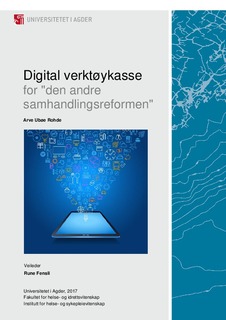| dc.contributor.author | Rohde, Arve Ubøe | |
| dc.date.accessioned | 2018-03-13T10:58:07Z | |
| dc.date.available | 2018-03-13T10:58:07Z | |
| dc.date.issued | 2017 | |
| dc.identifier.uri | http://hdl.handle.net/11250/2490269 | |
| dc.description | Masteroppgave i helse- og sosialinformatikk HSI500 - Universitetet i Agder 2017 | nb_NO |
| dc.description.abstract | Background. Domestic-aid services (IADL) counts for a substantial portion of public home care. There is a growing demand for these types of services, especially among younger recipients (under the age of 67). The demand is expected to grow because of an anticipated increase in the older population. Informal caregivers are viewed to be essential resources in meeting those demands, as found both in research and governmental policies. Interaction and coordination of services across organizations will be necessary.
Aim. The aim of this study is to find how home-dwelling care-dependent individuals can be empowered through the integration of informal resources with public home care.
Method. The study has a qualitative design. Data were collected by means of a workshop with five participants, representing recipients of public home care, relatives, public home care and voluntary organizations. The Chronic Care Model (CCM), first developed by MacColl Institute for Healthcare Innovation at Group Health Cooperative, serves as a theoretical framework.
Results. Relatives and volunteer resources can be involved in a wide range of assignments. Findings also show that a number of diverse volunteers can be involved in teams committed to the individual care recipient. The empowerment of the home-dwelling care-dependent individual requires close cooperation between all involved parties. Time-essential tasks demand additional attention. An information system for care coordination can support the coordination of services.
Conclusion. A multitude of potential assignments and available resources may bring a stronger sense of empowerment for the home-dwelling care-dependent individuals. Close cooperation and effective systems for information exchange seems to be prerequisites to accomplish this. Legal and technological clarifications may be necessary. The proposed specification for a coordinated care information system may contribute to further research and development.
Keywords: home care, social care, coordinated care, empowerment | nb_NO |
| dc.language.iso | nob | nb_NO |
| dc.publisher | Universitetet i Agder ; University of Agder | nb_NO |
| dc.rights | Attribution-NonCommercial-NoDerivatives 4.0 Internasjonal | * |
| dc.rights.uri | http://creativecommons.org/licenses/by-nc-nd/4.0/deed.no | * |
| dc.subject | HSI500 | nb_NO |
| dc.subject | home care | nb_NO |
| dc.subject | social care | nb_NO |
| dc.subject | coordinated care | nb_NO |
| dc.subject | empowerment | nb_NO |
| dc.title | Digital verktøykasse for "den andre samhandlingsreformen" | nb_NO |
| dc.type | Master thesis | nb_NO |
| dc.subject.nsi | VDP::Teknologi: 500::Informasjons- og kommunikasjonsteknologi: 550 | nb_NO |
| dc.subject.nsi | VDP::Medisinske Fag: 700::Helsefag: 800::Helsetjeneste- og helseadministrasjonsforskning: 806 | nb_NO |
| dc.source.pagenumber | 53 s. | nb_NO |

